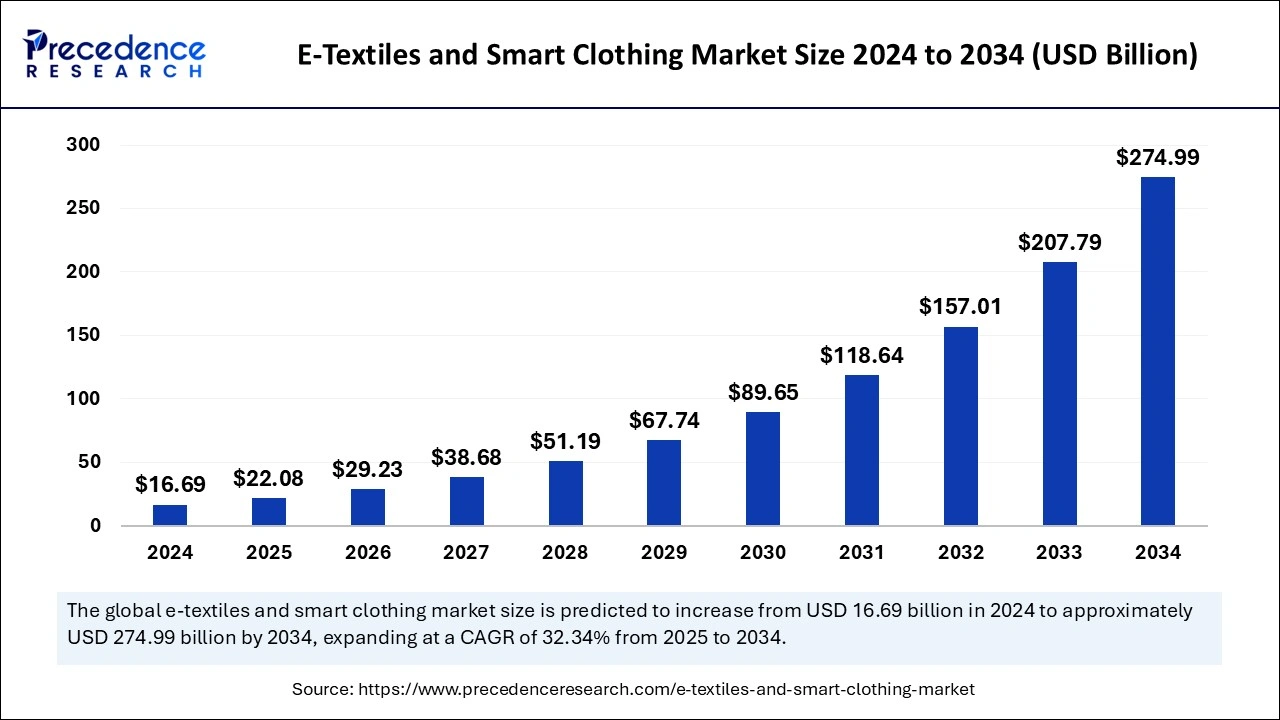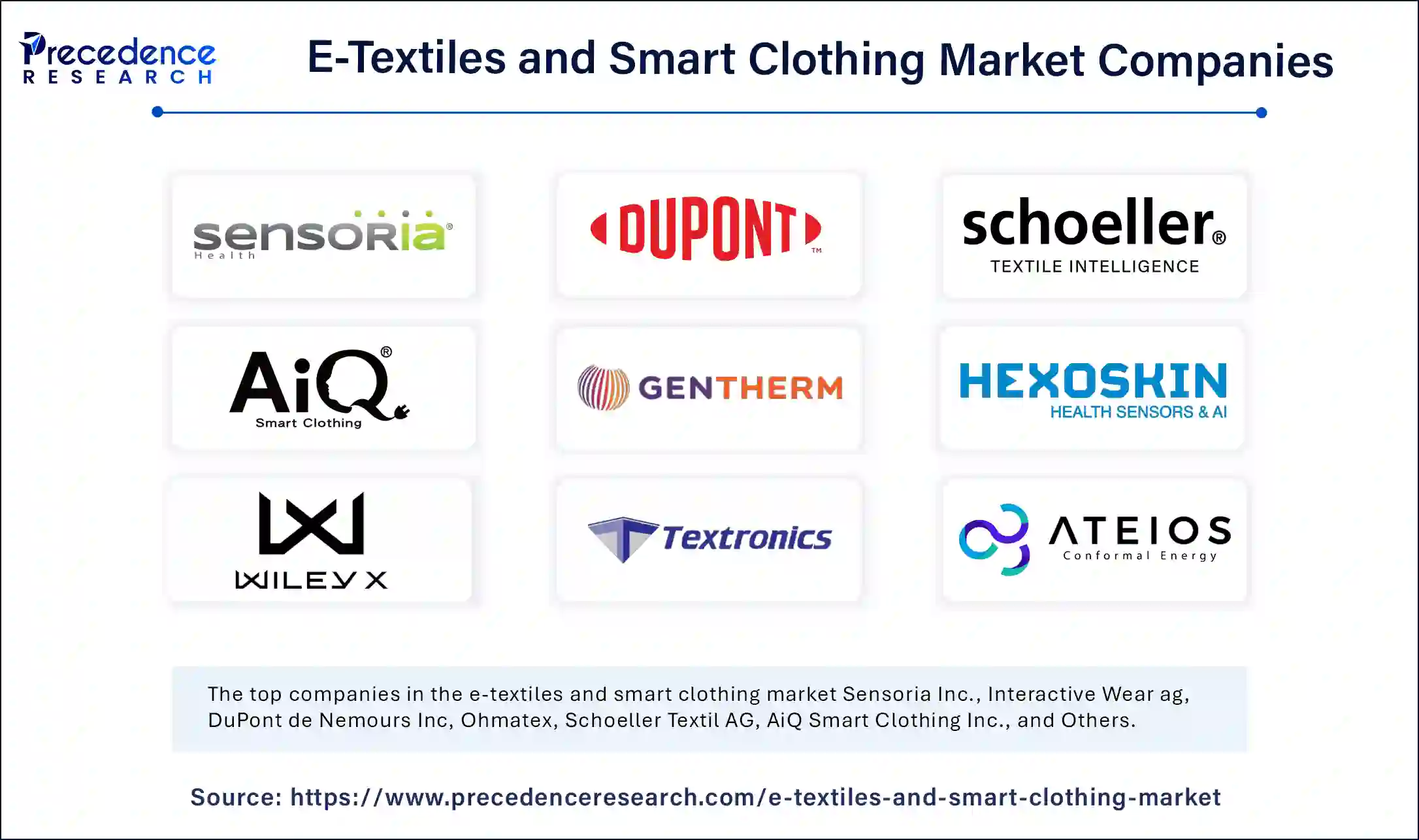August 2024
The global e-textiles and smart clothing market size is calculated at USD 22.08 billion in 2025 and is forecasted to reach around USD 274.99 billion by 2034, accelerating at a CAGR of 32.34% from 2025 to 2034. The market sizing and forecasts are revenue-based (USD Million/Billion), with 2024 as the base year.
The global e-textiles and smart clothing market size accounted for USD 16.69 billion in 2024 and is predicted to increase from USD 22.08 billion in 2025 to approximately USD 274.99 billion by 2034, expanding at a CAGR of 32.34% from 2025 to 2034. The rising demand for garments to monitor vital signs, track activity, and provide haptic feedback is fueling the growth of e-textiles and the smart clothing market.

Integration of artificial intelligence into the e-textiles and smart clothing market is transforming various industries, including fashion, technology, healthcare, and many more. AI holds the potential to make humans interact with garments to enhance their function, comfort, and personal experience. AI incorporates advanced electronic technologies directly into the fabrics, which offer features including environmental sensing, data processing, physiological monitoring, and adaptive response to various stimuli.
E-textiles, electronic textiles, and smart textiles are fabrics equipped with electronics to provide advanced facilities. This is a relatively new incorporation into wearable technology. E-textiles are designed with electronic components in the fabrics, which makes them washable and durable. Smart textiles embed with technologies that optimize their function and performance. These technologies are woven into the fabric or added to the surface of the fabric. The e-textiles and smart clothing market provides functionalities such as heating, active lighting, sensing, and actuation, which can be controlled by an electronic system. Some commonly noticed clothes are should shirts, smart socks, solar-powered tents, heated car seats, and many more.
| Report Coverage | Details |
| Market Size by 2034 | USD 274.99 Billion |
| Market Size in 2025 | USD 22.08 Billion |
| Market Size in 2024 | USD 16.69 Billion |
| Market Growth Rate from 2025 to 2034 | CAGR of 32.34% |
| Dominated Region | North America |
| Fastest Growing Market | Asia Pacific |
| Base Year | 2024 |
| Forecast Period | 2025 to 2034 |
| Segments Coverage | Textile Type, Product Type, End-User, and Regions |
| Regions Covered | North America, Europe, Asia-Pacific, Latin America, and Middle East & Africa |
Sports and healthcare industry
Even though e-textiles and smart clothes have a wide range of applications in the medical, military, fashion, safety, and many more fields, the market is predominantly driven by the sports and healthcare industries. It is primarily used to monitor the user’s vitals to analyze their health and performance. E-textiles and smart clothing market garments can aid in maintaining health and wells as they offers early detection of any sign of medical condition and monitor vitals and sleep patterns. Athletes are improving their performance with the help of smart clothing, which provides real-time feedback on techniques performed, forms, and biometrics.
Cyber Threat
With the increasing adoption and production of e-textiles and smart clothing, the risk of cyber-attacks is also increasing. Smart clothing collects users’ data and stores sensitive information about health and finances, which hackers can easily exploit or trade on the dark web. If the attackers get access to an individual’s smart clothing control, they might manipulate features such as heating elements, causing potential harm to the person. By getting access to GPS modules through garments, someone might misuse stalk, or invade privacy.
Innovative Breakthroughs
The e-textiles and smart clothing market is expected to witness promising growth in the future. With innovative technologies, the smart clothing industry will be able to offer more functionality and appeal to garments. Along with that, it is expected to address some of the challenges faced by the market companies and customers. The integration of 5G connectivity is booming in almost all industries, including e-textiles and smart clothing. 5G technology will significantly enhance the capabilities of the devices, offering faster and more reliable connectivity.
The real-time data transmission will provide a seamless interaction with the smart garment system. Moreover, the industry is moving towards creating power-generating devices that will be a reliable source of power in the future. The power generation will be drawn from individuals' physical activities, including body movement, body heat, or solar energy, leading to a reduction in the charging frequency.
The active smart segment dominated the e-textile and smart clothing market in 2024. Activewear incorporated with advanced technology such as the Internet on Things (IoT) transforms the way of exercising and optimizes and constantly improves an individual's performance. Smart clothing in combination with advanced textile technology with electronics makes the garments more comfortable and functional. IoT adds an extra layer of communication in real-time offering better analyses and outcomes for the user of active wear.
The passive wear segment is expected to grow at a rapid rate in the market by form during the forecast period. the passive wear clothing with smart technology does not necessarily have to embed with electronics or internet connection. It also suggests that this clothing does cnot ontain any sensors or wires. The functions of passive wear clothing allow it to remain in a static state which prevents static cling. After from being anti-static, these clothes are anti-microbial as well, which reduces the risk of getting sick by eliminating viruses and bacteria. Additionally, they prevent harmful UV rays, prevent sunburns and skin cancer, and promoting health and well-being.
The upper wear segment dominated the e-textile and smart clothing market by product type in 2024. The dominance of this segment is credited to the sensors embedded into the upper wear clothing which helps in monitoring heart rate, breathing rate, movement, body temperature and stress level. These features are commonly integrated in shirts or jackets. Popular brands such as Hexoskin and Sensoria Fitness, Komodotec and LifeBEAM are known to produce smart shirts and active wears.
The lower wear segment is expected to grow to the highest CAGR in the market by application during the forecast period. The incorporation of build-in sensor in lower wear is growing as it aids in tracking movement, monitoring muscle activity, provide feedback regarding postures and also detect potential injuries. The lower wear with smart technology clothing includes pants, shorts and leggings. This allows for real-time data collection and analysis about fitness and health.
The sports & fitness segment dominated the e-textile and smart clothing market by end-user in 2024. Clothing with smart technology is incorporated with sensors and biometers on shirts and shorts. These devices help in measuring heart rate, calories expenditure, rest time compared to active time and many more. It also provides with feedback on the user’s smartphone. This approach offers a continues improvement in data accuracy, style, availability and cost in achieving trendy fitness.
The military & defense segment is observed to grow at a significant rate during the forecast period in the market. The military is using smart clothing and body sensors is gaining popularity. The military uniforms are designed to improve the health of the soldier along with proving battlefield information. Smart military clothing protects against injury, have ability to detect wound and monitor health and stress.
North America: The Hub for E-Textile and Smart Clothing Market
North America contributed the largest shares of the e-textiles and smart clothing market in 2024. This dominance is due to the rising smart clothing research and development, which enhances technologies and creates a better lifestyle environment. North America has the highest number of wearable technology devices, including smart clothing, a strong company presence, and a research institute working towards developing innovative e-textile technologies with great investment.
Asia Pacific: The Future of E-Textile and Smart Clothing
Asia Pacific is estimated to expand the fastest CAGR in the e-textiles and smart clothing market between 2025 and 2034. The expansion of this region is experienced due to government support and technological advancement. East Asia countries show a positive response towards the market, particularly China, Japan, and South Korea, which are making hefty investments in the development of e-textiles and smart clothing. Innovative technological advancements are utilized in the healthcare system and military. Integration of this technology enhances healthcare management, which includes facilities, staff recruitment and training, patient care standards, and many more. In military and defense applications, smart clothing technology focuses on soldier safety and operation efficiency.

In August 2024, Pierre-Alexandre Fournier, Hexoskin’s CEO, commented: “Hexoskin’s team has over 15 years of experience with clinical AI development and high-resolution wearable sensors. The investors of the company understand how our digital platform is uniquely positioned to develop a range of diagnostic tests and digital solutions that can tackle the issue of large populations in disease areas with large unmet needs, such as cardiac, respiratory, and rare diseases.”
By Textile Type
By Product Type
By End-User
By Geography
For inquiries regarding discounts, bulk purchases, or customization requests, please contact us at sales@precedenceresearch.com
No cookie-cutter, only authentic analysis – take the 1st step to become a Precedence Research client
August 2024
December 2024
November 2024
April 2025